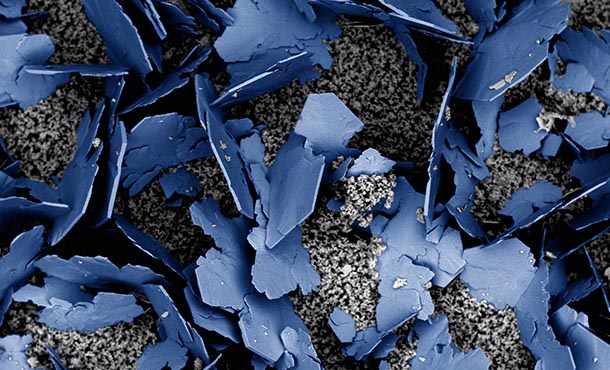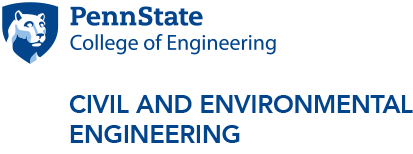
This image, taken from a scanning electron microscope, shows false-colored portlandite (calcium hydroxide) crystals sitting on top of a C-S-H matrix, seen from the surface of a 3mm thick sample. The sample is hydrated tricalcium-silicate, which is the main compound of ordinary Portland cement. Photo: MSFC-EM31 Materials Diagnostics Lab/ Juliana Neves/Peter Collins (Homepage photo: NASA)
Concrete in Space
Investigating cement solidification in a microgravity environment
01/23/2019
By Jennifer Matthews
UNIVERSITY PARK, Pa. – “Be prepared.” This famous mantra isn’t just for the Boy Scouts of America. The need to build durable infrastructure on other planets is coming, and we must be ready. To prepare, Penn State researchers have teamed up with NASA to explore how cement solidifies in microgravity environments.
“It is no longer a question of if we will need to colonize other planets, but a question of when,” said Aleksandra Radlińska, assistant professor of civil engineering at Penn State and principal investigator on the project. “Once we begin sending humans on missions to the Moon and Mars, we will have to provide them with safe environments to stay in for the duration of their mission.”
Researchers have long been studying the reaction of cement when it mixes with water here on Earth; however, there are still questions remaining and little is known about how this process plays out in space, where there is little to no gravity. The goal of this research is to better understand the complex process of cement solidification when gravity is taken out of the equation.
“We're looking at how cement hydrates and how its microstructure develops over time,” said Radlińska. “We want to know what grows inside cement-based concrete when there is no gravity driven phenomenon.”
Microstructural development of concrete occurs in stages—when the cement is exposed to water and when the mixture undergoes the complex process of solidification. What happens during these stages leads to the development of elaborate combinations of amorphous and crystal phases. The shape, volume, and distribution of these determines the properties of the hardened material. This process is altered when gravity is minimized considerably, which changes the crystalline structure, and ultimately the material itself.
To learn more about how cement reacts in these environments, the researchers embarked on a two-phase study.
During the first phase, the team sent 120 pre-packaged samples to the International Space Station (ISS), a working science lab in space. Sample packets included two or three separated compartments containing cement and water, or cement, water and alcohol (the latter was used to stop the hydration reaction at given time interval). While in orbit, an astronaut onboard the ISS was tasked with hydrating each sample by bursting the water packet into the cement packet and then halting the hydration at a given point using the alcohol for certain samples. This series of experiments varied the type of cement, the type of additives, the number of additives, the amount of water, and the length of time until the hydration was stopped. The samples were then returned to the Marshall Flight Center in Huntsville, Alabama and then transported to Penn State where they are currently being tested and characterized in detail.
During the second phase, the researchers sent 28 additional samples to the ISS. In this phase, the astronauts mixed the two-compartment samples as they did in the first phase but then used a centrifuge to simulate three gravity levels. These gravity levels included the Moon, Mars, and 0.7-g, which is in between the other two. This phase of the study will help the team determine the differences in the hydration reaction based on varying levels of gravity.
“All planets vary in their gravity levels,” Radlińska said. “Mars is only one third of the Earth’s gravity, but there is still some gravitational force.”
Once the results have been compiled, this research will be helpful in understanding how to use cement as a building material in space, but the knowledge gleaned will also be beneficial to improving Earth-based cement and concrete processing. Concrete is the single most widely used human-made material in the world, with global production reaching roughly 10 billion tons per year – and it has a carbon footprint to match. Even a slight improvement in the process could have huge implications on the sustainability of cement-based infrastructure.
“There is a lot of carbon dioxide emitted into the atmosphere during cement production,” said Radlińska. “The more we understand those early stages of hydration, which we don't on Earth yet because it's a very complex process, the more we can improve it.”
Once the team has a better understanding of the hydration process of traditional, portland-based cement, it would like to begin testing the process using materials indigenous to Mars. Though direct samples are hard to come by, the team can recreate these materials based on the chemical composition of existing samples tested by the Mars rovers.
“That's why this research is so important,” said Radlińska. “Once we’ve run the research in space, we know the principles, and we can further test the materials on Earth. … The next stage of industrial development will be colonization of space and civil engineers will play a crucial role.”
Researchers on this project include Richard Grugel, a materials scientist with NASA; Barry Scheetz, professor of materials, civil, and nuclear engineering at Penn State; Juliana Neves, a doctoral student in civil engineering at Penn State, and Peter Collins, a graduate student in civil engineering at Penn State. Implementation partners for the space flight were Leidos and Techshot, Inc. Industry collaborators include BASF, Ipenex and Sauereisen.



